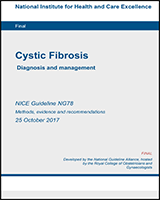From: 9, Pulmonary monitoring, assessment and management

NCBI Bookshelf. A service of the National Library of Medicine, National Institutes of Health.
| Comparison 6. Positive expiratory pressure (PEP) compared to oscillating device for CF | ||||||
|---|---|---|---|---|---|---|
| Outcomes | Illustrative comparative risks* (95% CI) | Relative effect (95% CI) | No of Participants (studies) | Quality of the evidence (GRADE) | Comments | |
| Assumed risk | Corresponding risk | |||||
| oscillating device (OD) | Positive expiratory pressure (PEP) | |||||
| Patient preference: self-withdrawal due to lack of perceived effectiveness Follow-up: mean 1 years | 250 per 1000 | 22 per 1000 (2 to 385) | RR 0.09 (0.01 to 1.54) | 40 (McIlwaine 2001) | ⊕⊝⊝⊝ very low1,2 | |
| Hospitalizations for respiratory exacerbations number per participant Follow-up: mean 13 months | The mean number of hospitalizations for respiratory exacerbations in the OD group was 0.7 per participant | The mean hospitalizations for respiratory exacerbations in the PEP groups was 0.4 lower (0.92 lower to 0.12 higher) | 42 (Newbold 2005) | ⊕⊕⊝⊝ low3,4 | ||
| Lung function - FEV1 % change from baseline Scale from: 0 to 100 Follow-up: 2–4 weeks | The mean % change from baseline in FEV1 in the OD group was 3.66 | The mean % change from baseline in FEV1 in the PEP groups was 4.08 higher (4.66 lower to 12.82 higher) | 6 (Padman 1999) | ⊕⊝⊝⊝ very low4,5 | ||
| Lung function - FEV1 % change from baseline Scale from: 0 to 100 Follow-up: mean 6–12 months | The mean % change from baseline in FEV1 in the OD groups was −10.95 | The mean % change from baseline in FEV1 in the PEP groups was 9.71 higher (2.12 lower to 21.54 higher) | 30 (McIlwaine 2001) | ⊕⊕⊝⊝ low1,4 | ||
| Lung function - FEV1 % change from baseline Scale from: 0 to 100 Follow-up: 1–2 years | The mean % change from baseline in FEV1 in the OD groups was 2.78 | The mean % change from baseline in FEV1 in the PEP groups was 2.82 lower (6.36 lower to 0.72 higher) | 160 (McIlwaine 2013, Newbold 2005, Tannenbaum 2005) | ⊕⊕⊝⊝ low4,6 | ||
| Lung function - FVC % change from baseline Scale from: 0 to 100 Follow-up: mean 1 years | The mean % change from baseline in FVC in the OD groups was −0.07 | The mean % change from baseline in FVC in the PEP groups was 0.44 lower (6.66 lower to 5.78 higher) | 160 (McIlwaine 2001, McIlwaine 2013, Newbold 2005) | ⊕⊕⊝⊝ low6,7 | ||
| Lung function - FVC (% predicted) Scale from: 0 to 100 Follow-up: 2–4 weeks | The mean FVC % predicted in the OD groups was 99 % predicted | The mean FVC % predicted in the PEP groups was 2 lower (4.09 lower to 0.09 higher) | 22 (van Winden 1998) | ⊕⊕⊕⊝ moderate4 | ||
| QOL – CFQ-R: physical domain Scale from: 0 to 100 Follow-up: mean 1 years | The mean CFQ-R - physical domain in the OD groups was −3.04 | The mean CFQ-R - physical domain in the PEP groups was 2.2 higher (1.32 lower to 5.72 higher) | 107 (McIlwaine 2013) | ⊕⊕⊕⊕ high8 | ||
| QOL – CFQ-R: treatment burden Scale from: 0 to 100 Follow-up: mean 1 years | The mean QOL-CFQ-R: treatment burden in the OD groups was −3.6 | The mean QOL – CFQ-R: treatment burden in the PEP groups was 1.05 higher (6.35 lower to 8.45 higher) | 107 (McIlwaine 2013) | ⊕⊕⊕⊕ high8 | ||
| QOL – CFQ-R: respiratory domain Scale from: 0 to 100 Follow-up: mean 1 years | The mean CFQ-R - respiratory domain in the OD groups was 0.19 | The mean CFQ-R - respiratory domain in the PEP groups was 2.79 higher (3.68 lower to 9.26 higher) | 107 (McIlwaine 2013) | ⊕⊕⊕⊝ moderate8,9 | ||
The basis for the assumed risk (e.g. the median control group risk across studies) is provided in footnotes. The corresponding risk (and its 95% confidence interval) is based on the assumed risk in the comparison group and the relative effect of the intervention (and its 95% CI).
Abbreviations: CI: confidence interval; CFQ-R: cystic fibrosis questionnaire revised; FEV1: forced expiratory volume in 1 second; FVC: forced vital capacity; MD: mean difference; OD: oscillating device; PEP: positive expiratory pressure; RR: risk ratio
The quality of the evidence was downgraded by 1 due to reporting bias.
The quality of the evidence was downgraded by 2 due to very serious imprecision as 95% CI crossed 2 default MIDs
The quality of the evidence was downgraded by 1 due to differences in baseline characteristics (pulmonary function values) between both groups.
The quality of the evidence was downgraded by 1 due to serious imprecision as 95% CI crossed a default MID
The quality of the evidence was downgraded by 2 due to attrition bias and reporting bias.
Taking into account weighting in a meta-analysis and the likely contribution from each component, the quality of the evidence was downgraded by 1 due differences in baseline participant characteristics.
The quality of the evidence was downgraded by 1 due to serious heterogeneity (I-squared inconsistency statistic of 69%) and no plausible explanation was found with sensitivity analysis.
Clinical MID=8.5 was used to assess imprecision because the CFQ-R questionnaire (Quittner et al. 2009) was used
The quality of the evidence was downgraded by 1 as 95% CI crossed 1 clinical MID
From: 9, Pulmonary monitoring, assessment and management

NCBI Bookshelf. A service of the National Library of Medicine, National Institutes of Health.